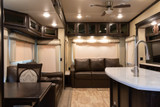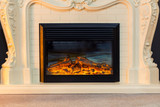Boondocking
The best things in life are free. It’s an old saying that holds a lot of truth and in the world of recreational vehicles, it’s especially true. When so much about the RV lifestyle has cost attached to it, it’s nice to take advantage of those rarest of opportunities. When it comes to the best of free for your RV, we’re talking about boondocking.
What is boondocking? Boondocking (also known as “Wild Camping”, “Dispersed Camping”, “Off the Grid”, “Off the Cord”, and “Roughing It”) is when an RV owner takes their rig into areas where there are no water, sewer, or electrical hook-ups. For enthusiasts this is the purest form or RVing and what the lifestyle is all about. While it’s not “pure camping” for the more extreme perspectives of outdoorsmen, it still takes a lot of preparation, work, and tenacity to properly pull it off. So, if it’s so difficult to do then why do people boondock in the first place? We’re going to take a look at the “hows” and the “whys” of boondocking and help you decide for yourself if boondocking is for you.
What’s beyond them there hills?
The explorer’s spirit is strong with the boondocking nation. The true adventurers of the RV world don’t just want to park in a campground stuffed to nearly overflowing levels with RVs only a scant few feet from one another. That kind of vacationing isn’t getting away from it all. That’s going to where everyone else is and hoping your roller shades can give you some privacy. Boondockers don’t want that. Boondockers want to go where the people aren’t. They’re drawn to explore the areas where they can get in touch with nature and put the life of modern society behind them. Boondockers aren’t necessarily misanthropes, but they could be confused with being mobile hermits.
All of the labels that Boondockers take on don’t really fit. They’re a large contingent of the RV world, yet they’re not wholly understood. Most Boondockers, when you get right down to it, are RV owners that want to reconnect with nature, and themselves. They aren’t some strange fringe sect of the RV world. They’re just looking for something a bit more (in their eyes) pure, than traditional modern camping and RV practices.
How does one…Boon?
The first thing you need to do as a new boondocker is know your destination. There are many areas that you can take your RV to at all points of the compass. Each with their own special climate and topographical considerations. You can’t just wheel off to the desert plains of Washington State and park in the middle of nowhere all willy and nilly. Are you on tribal lands?Is that a bear you hear outside of your window? Are there even bears local to this area? Information about the area you are traveling to is crucial for you to properly plan out your trip.
Let’s assume that your destination is somewhere in the deserts surrounding Phoenix, AZ. You can already make some assumptions about gear that you will need for your trip:
- Solar Panels
- Anti-Venom kit for your first-aid (the area is known to have tarantulas, rattlesnakes, and scorpions)
- Full water tanks (and even spare cases of water in your storage)
- Sun protection (sunscreens, long sleeve shirts and pants, wide-brimmed hats, umbrellas)
- Coolant
- Tire repair tools (fix-a-flat, spares, miniature portable air compressors)
- Fans
This list is not meant to be complete by any means, but just an example of items that you will need (at a minimum) to have with you when you head off into the places beyond the horizon.
You know where you want to go, but can you?
Just because you have a destination in mind doesn’t mean you can go there. Well, you can, but it doesn’t mean you’re allowed to be there legally or that you can even get your bulky RV to your desired destination. While we live in a free country, that doesn’t mean you have free reign to go where you may. Don’t believe it? Try going anywhere close to the fabled Area 51 near Roswell, NM. Push your luck and we’ll see you in 3 to 5 years.
So, with all of the unknowns, how do you figure out how to map your path to the great outdoors? The internet is a great place to start. From a plethora of online opinion articles to government sites, here is a short list to help you get started:
Public Lands App – This is a great app if you’re looking for an inexpensive way to find general boundaries of public land that is under federal control. The reviews for the app are generally high (averaging 3.7) with the major complaints being that the app does not do a good job of listing state land and can potentially label private land as public.
BLM – The Bureau of Land Management is the “go to” source of information for public lands around the country. With regular updates, news, and maps to guide you where to go, the BLM is an invaluable tool to utilize in your boondocking travels. You can find their site here:https://www.blm.gov/
National Park Service – Parks are a great and often visited destination for Boondockers. The national parks in the United States hold some of the most beautiful vistas that can enrich your camping experience while you’re camping the wilds. This website will help you find great locations by state and even help you plan your getaway adventure. Your adventure begins here:https://www.nps.gov/index.htm
Now that you know where you can go, make your plans, get a proper inventory for the area you’re travelling to, and hit the road. Boondocking, after you get through the preparation phase, is really very simple. Find a secluded spot (where you’re allowed to be) and make camp. Just make sure you have plenty of lighting, water, and solar (and gas!) to get you in and out of your getting away from it all destination.
Recent Posts
-
Can You Put Regular Furniture in an RV?
Many new and old RV owners ask themselves this question when they feel the need to update th …Apr 25th 2024 -
4 Tips for Securing RV Furniture While Traveling | RecPro
How To Secure RV Furniture There are few things that beat going out on an adventure with an RV …Apr 25th 2024 -
How To Keep RV Furniture From Peeling
Peeling RV Furniture | Why it Peels and How to Stop it Your RV furniture is a point of pride on yo …Apr 25th 2024 -
Turning up the Heat With an RV Fireplace
There’s an unlimited number of cool and exciting features you could add to your recreational vehicle …Apr 25th 2024 -
How To Install An RV Fireplace
A Warm Addition to Your On-Wheels: The DIY RV Fireplace Installation Guide Many RV enthusiasts ask …Apr 25th 2024 -
Are RV Electric Fireplaces Safe
Being Safe in Your RV with an Electric Fireplace Safety is always going to be one of your highest …Apr 25th 2024







